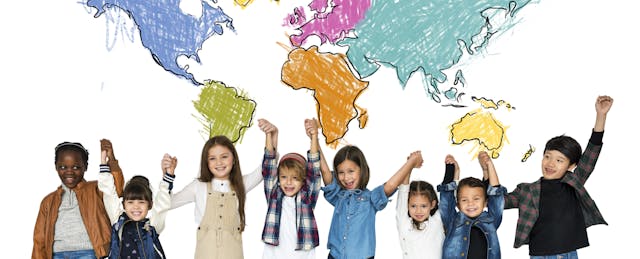Zerifa Radlein-Grant is quietly changing students’ lives by introducing them to the world.
When Radlein-Grant finished her teaching degree in 2015, she left her home in Jamaica to teach third grade in Fayetteville, NC, where one in four children lives below the poverty level. Many of the students in her classroom at Teresa C. Berrien Elementary had never been outside the city, couldn’t name the state capital and had never met someone who wasn’t from the United States.
Undeterred by her students’ circumstances, Radlein-Grant decided to bring the world to them in any way she could. She started by sharing her own culture and working with another teacher to arrange a field trip to the state capitol. Eventually, she discovered a way to bring other parts of the world directly into her classroom through video calls with international classrooms—an experience her students are still talking about.
Radlein-Grant talks to EdSurge about how her global education lessons create opportunities for social-emotional learning (SEL), expand student thinking and give her students hope for a bright future.
EdSurge: Why do you embrace global education in your classroom?
Radlein-Grant: I want students to know there's more to life than what they’re experiencing. Outside of school they're not necessarily seeing a lot of good around them. Cumberland County is one of the top counties for opioid usage.
Exposing them to the world and exposing them to new ideas lets them see there's somewhere much bigger than Fayetteville. It tells them they can have hopes and dreams.
How did you begin incorporating global education into your teaching?
When I started, we’d have Fun Fridays and I would teach them about my culture using videos. I taught them about Jamaica’s national anthem and our flag. One of my students was starting to run track, so I told them about Usain Bolt and how track was another great part of my culture.
I also set up pen pals with a school in Jamaica, and they wrote letters back and forth. But my students wanted more. They had so many questions. "How do kids there get to school? What do they do? Do they have computers?”
I was trying to find a school that had the internet to be able to Skype. It was also hard to find a day that worked for both of our classes.
So I started looking for more in-depth ways for us to connect with other classrooms. That’s when I found Empatico, a free tool that made connecting with other schools so much easier.
How does it work?
You just fill out some basic information, choose the activity you want and the times your class is typically free and they find you a teacher with a matching profile. We were paired with a class in Kamloops, British Columbia within two weeks and then we set up a time for our classrooms to connect.
Empatico even gave us the lesson plan—a run-through of things that you could do. They provided follow-up activities based on the connection that we had. I’m an ELA teacher, so I tied it into culture in my social studies lessons.
It’s easy to use and you can use technology that you already have in your classroom. We used our laptop, and I connected it to my SMART Board so when kids weren’t asking questions at the laptop they could look at the video on the board. Plus, it’s free!
Tell me about your class’s connection. How did it go?
The kids were so excited. We had our live video connection in January and since we were studying culture at the time, we did a little research on British Columbia beforehand. We talked about their culture and watched videos. I wanted to give them an idea of what kind of questions to ask, but I wanted them to come up with the questions on their own.
Three students volunteered to introduce our school, talk about the location, what it's like, and then ask questions during the connection—just to break the ice. But once they started talking, the questions kept coming. Our connection lasted for 40 minutes! It was something they just did not want to end. Even kids who were shy or quiet wanted to ask questions.
It’s definitely something I’ll continue to do with my classes.
What were some of the benefits of the connection?
They got to be exposed to a different culture. The day we spoke, it was really cold and the kids in Canada were bundled up. So my students were excited to see that the kids actually went outside even though it was snowing.
They found some similarities and differences. Then we were able to compare and contrast with them. For example, they all play games like Sardines and tag. One student said to me, ‘They wear clothes just like us to school, I was expecting uniforms.’ Another student said, ‘The kids look nice.’ Another student reflected that she thought the kids were well behaved.
What kind of impact have the global education activities had on your students?
I’ve seen a social-emotional learning aspect to this. Last year, I had a student that was from Puerto Rico and when she came to the school she didn’t speak English. She was quiet, and the students didn't warm up to her at first.
But the discussions we had about my experiences as an immigrant—and how students from other countries are similar to them—changed that. They started treating her differently. They were nicer to her.
I remember we talked about what it would feel like to be an immigrant and move from a different country. One student said, ‘I wouldn't have my family.’ Another said, ‘I would lose all my friends.’ And one student, referencing her peer from Puerto Rico, said, ‘Her mommy is not here. That must be hard.’
What advice do you have for other teachers who want to bring global education into their classrooms?
I would tell them, you don't have to be an educator from another country—like I am—to teach kids about the beautiful world that's out there. You and your students will learn so much from this experience and it will change your perspective, too.






